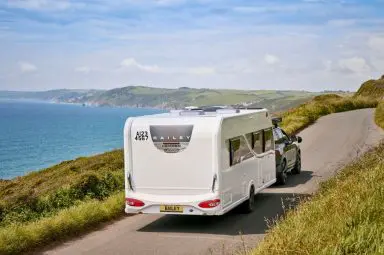Dogs in Motorhomes: The Ultimate Guide for UK Travellers | Bailey of Bristol
According to recent surveys by the Caravan and Motorhome Club, a whopping 86% of UK dog owners now travel with their pets. While caravans still lead the pack overall, motorhomes are becoming a go-to option for pet-loving tourers who want everything in one place.
So whether you’re new to motorhome travel and wondering if it’ll suit your dog, or you’re already a regular road-tripper planning your first pet-friendly getaway, this guide will walk you through everything you need to know to make your motorhome trip safe and enjoyable for both you and your four-legged friend.
Let’s get into it.
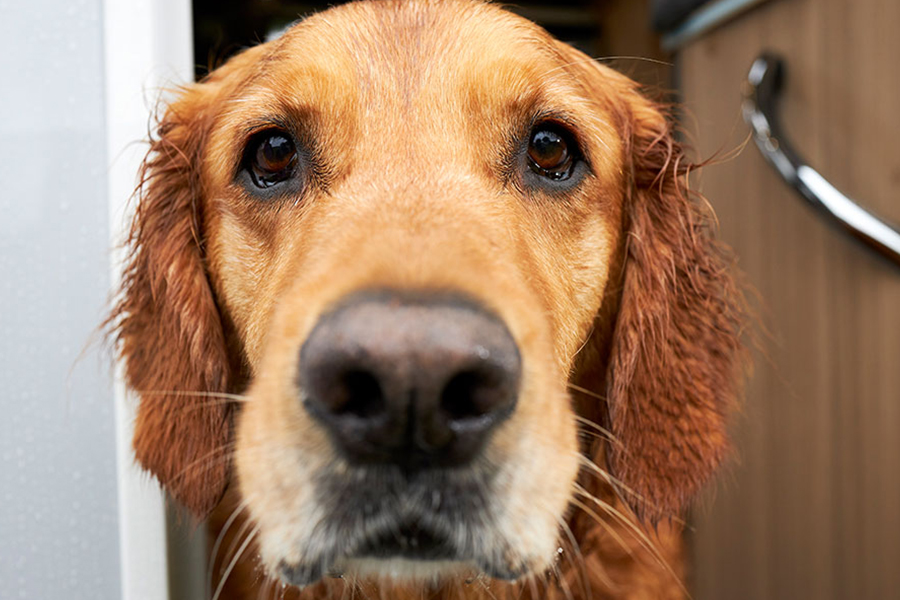
The big question: Can dogs travel in motorhomes?
Yes, and it’s one of the biggest perks of travelling this way.
Motorhomes let your dog stay with you in the main cabin as you drive, which means you can keep an eye on them,making sure they keep cool, don’t worry and have enough water throughout the journey.
Just like when you take your dog in any vehicle, the UK law on dogs in motorhomes is that when travelling, your dog must be “suitably restrained”, but we’ll cover this in more detail below.
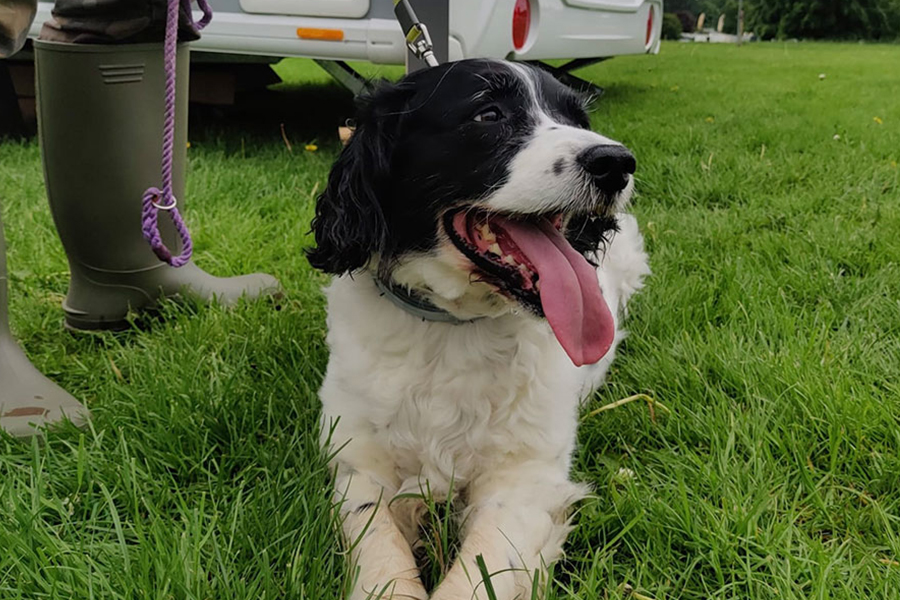
How to plan for a caravan holiday with your dog?
Before you hit the road, there are a few must-dos that’ll help make sure your trip runs well for you and your dog.
How to sort the dog travelling essentials?
If you’re staying within the UK:
- Microchip: Your dog should already be chipped by law, but it’s especially important when you’re away from home. New places = new smells = lots of curiosity, which can sometimes lead to wandering off.
- ID Tags: Make sure your dog’s collar has clear ID. Include their name, your name, a mobile number and even your campsite name if you like. It’ll help anyone who finds them get them back to you quickly.
- Pet Insurance: If you don’t have it already, get insurance sorted before you go, and keep the policy info handy: either printed or saved to your phone, tablet or laptop.
- Vaccination Records: These should be up to date and easily accessible, especially in case of emergencies.
- A Recent Photo: Hopefully, you’ll never need it, but having a clear, recent picture of your dog can make all the difference if they go missing.
If you’re heading into the EU
You’ll need all of the above, plus a few extra steps:
- ISO-Standard Microchip: Your dog must be chipped to ISO 11784/11785 standards either before or at the same time as their rabies jab.
- Rabies Vaccination: Legally required for EU travel.
- Animal Health Certificate (AHC): Since Brexit, UK pet passports are no longer valid for EU trips. You’ll need to get an AHC from an official vet within 10 days of travel. It’s valid for one trip and up to four months of onward travel in the EU.
- Tapeworm Treatment: Required 1–5 days before entering countries like Ireland, Norway, Finland and Northern Ireland (also needed before re-entering the UK). This must be done and signed off by a vet.
It’s worth speaking to your vet in good time before your trip, especially if it’s your first time taking your dog abroad. You can find full details of all the steps you need to take before travelling with your dog on the government information page here.
How to find a dog-friendly campsite?
Not all campsites are pet-friendly, so it’s always worth double-checking before you book. Look out for dog-friendly caravan sites that offer:
- A dog walk area (ideally one that’s fenced, so your dog can roam safely off-lead)
- Plenty of dog waste bins dotted around the site
- Easy access to longer walks or nature trails
- A small on-site shop with dog food, treats or other essentials
Even if dogs are allowed, each site will have its own rules. Some may ask that dogs stay on-lead at all times, while others allow tethering outside the van. And some may have off-limits areas, like playparks or cafés; so a quick check of the site’s dog policy saves you any surprises.
What are the top club sites for dog owners?
- The Caravan & Motorhome Club – Filter by dog-friendly caravan sites when searching
- The Camping & Caravanning Club – Same goes here, and you can add filters for family-friendly features too
These tools are great if you’re looking for a site that needs to cater to your dogs and the entire family. You’ll be able to search for everything from pet zones to play areas and clubhouses for the kids.
Top tip: Search for honest recommendations
Have a look at online forums or Reddit threads to see which campsites, walks and attractions are favourites with fellow dog owners.
It’s a great way to plan your trip around places that actually deliver on the ‘dog-friendly’ promise.
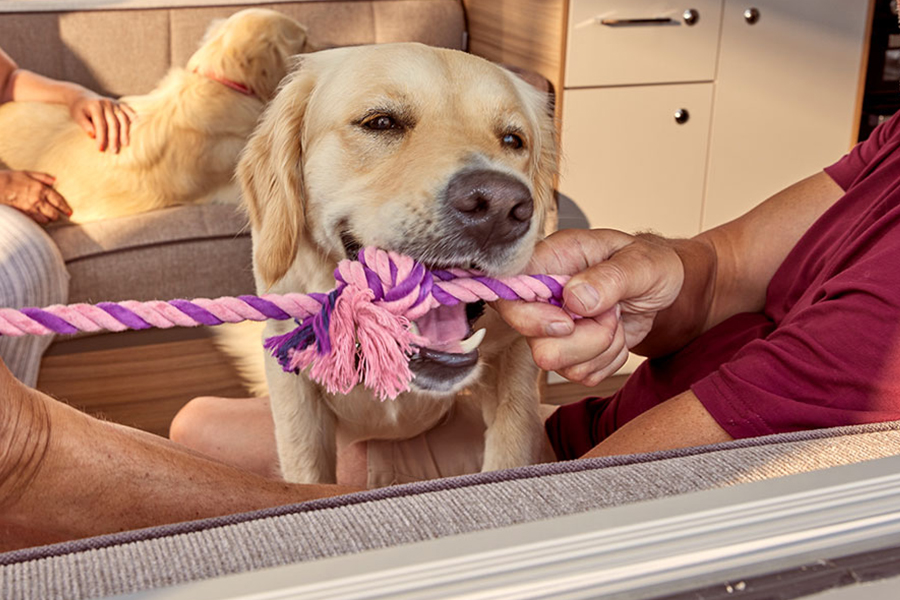
How to travel with a dog in a motorhome?
When you’re heading off on a motorhome trip, your dog’s safety on the road is just as important as your own.
According to Section 57 of the Highway Code, drivers must ensure that animals are “suitably restrained” when travelling in a vehicle. In a motorhome, that means securing your dog in a way that keeps them safe and stops them from distracting the driver.
How to secure a dog in a motorhome
To ensure your dog doesn’t distract you when driving, choose one of these secure travel options depending on your dog’s size, temperament and travel style:

- Dog harnesses: These attach to your motorhome’s seatbelt system, making them great for dogs who prefer a bit of freedom while still being safely buckled in.
- Dog car seats: Smaller dogs who love a window view will appreciate a secure seat that lifts them up safely.
- Dog guards: In some motorhomes with garage-style storage or large rear seating areas, a fitted guard can section off a space just for your dog, provided it’s well-padded and ventilated.

Why does your dog need to be restrained?
Aside from the obvious safety risks of an unsecured dog in a vehicle that may need to stop quickly, a loose dog in a moving motorhome can quickly become a distraction. Even the most laid-back pets might suddenly do something that distracts the driver, and that’s not what you want when you’re trying to focus on the road.
How to keep your dog safe and comfortable while travelling?
Security is only half the story. Here’s how to make sure your dog is comfy while you’re on the move:
- Water: Keep a full bottle and travel bowl within easy reach, and offer your dog a drink regularly, especially if it’s warm. Just like us, dogs can get dehydrated quickly on long journeys.
- Walks: Plan a proper stop every hour or two on long journeys so your dog can stretch their legs and take a toilet break. Services with green space or a quiet picnic spot are perfect, so keep an eye out for those.
- Temperature: If you’re feeling warm, your dog’s likely too hot. Use air con or pop open a window (if safe to do so). Keep an eye out for panting, restlessness or drooling, because these can be early signs they’re overheating.
- Keeping them calm: If your dog’s not keen on noisy motorways, try plotting a scenic route instead. Country roads or coastal drives might add a little time, but they can help nervous dogs to feel more secure.
- Tech accessories: If your dog’s travelling in the back of the motorhome or crate, a rear-seat dog camera or monitor can help you keep an eye on them while you drive. This is great for your peace of mind, especially if they’re a long way in the back.
Top tip: If this is your dog’s first proper trip, start small
If this is your dog’s first trip in a motorhome, start with a short local drive and stay somewhere nearby.
Once they’re used to the feel and movement of the vehicle, and know what to expect, you can build up to longer journeys and more adventurous routes.
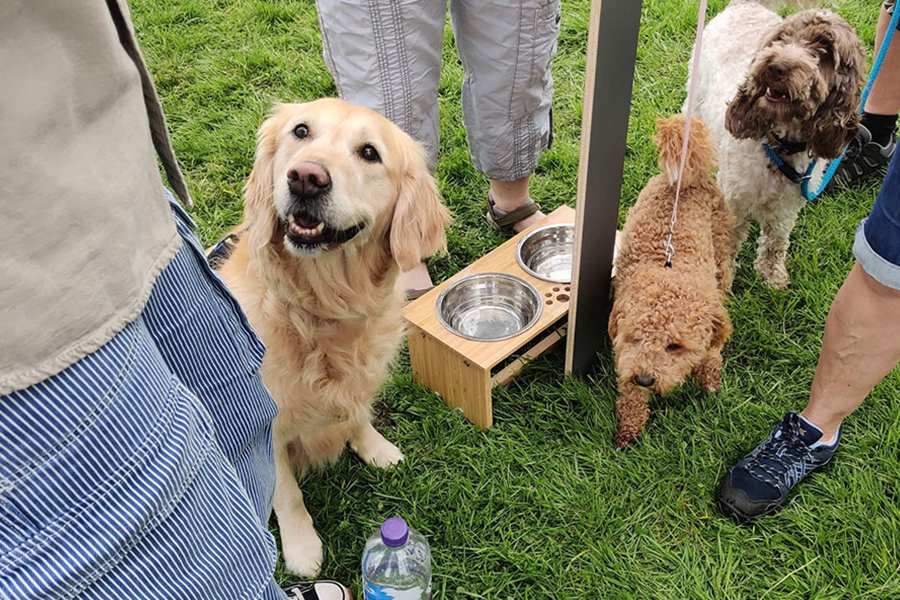
How to set up your caravan for your dog?
With a few simple tweaks, you can create a little ‘den within the van’ that helps them feel safe and at home.
Inside the Caravan

- Create a calm space. Your dog will love having their own space to relax in. That could be a pet bed tucked into a quiet area or a favourite blanket laid out on the sofa. Having “their” space helps reduce restlessness and gives them somewhere to settle when things get busy.
- Keep food and water accessible. Set their bowls somewhere they can always reach. Ideally somewhere wipe-clean like the washroom floor. Just remember to keep the door open!
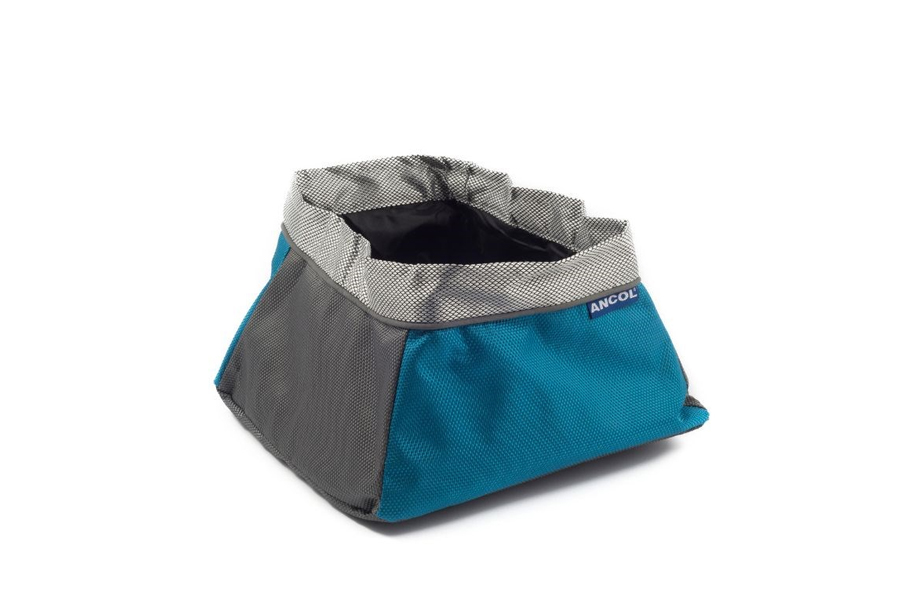
- Do a quick hazard sweep. After every setup, have a look around at dog height. If your dog’s still young or very curious, it’s even more important.
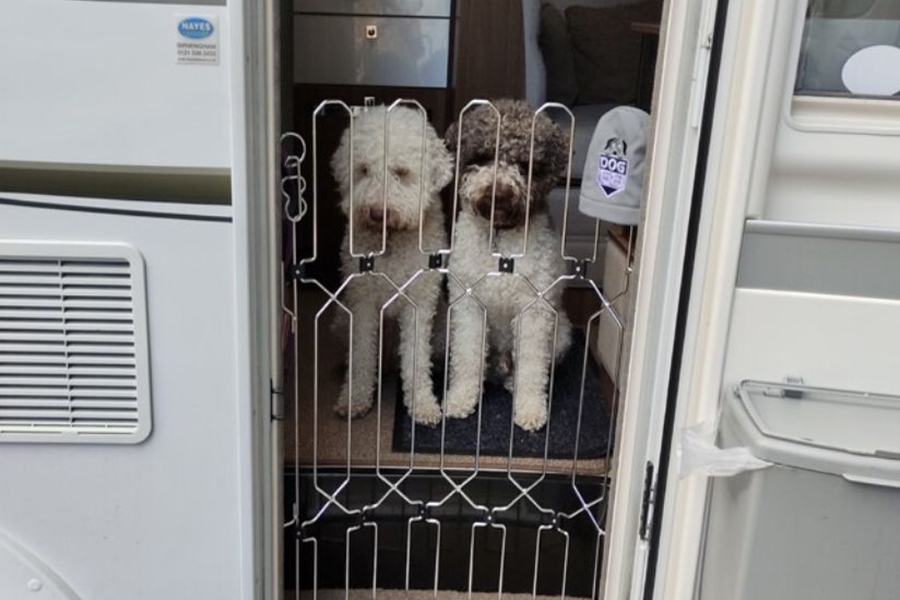
- Use a dog-proof door screen. Most motorhomes come with built-in mesh doors or flyscreens, which are brilliant for letting air in while keeping pets safely inside. If yours doesn’t, consider adding a removable screen or portable gate so you can prop the door open without worrying about them escaping.
- Protect your upholstery. If your dog’s a sofa-lover or a bit muddy after walks, you might want to throw covers over your cushions or beds. It’s a quick way to stop messes or scratches from becoming a problem. Another great option is a portable pet-washing device that allows you to wash your dog off before they even enter your van
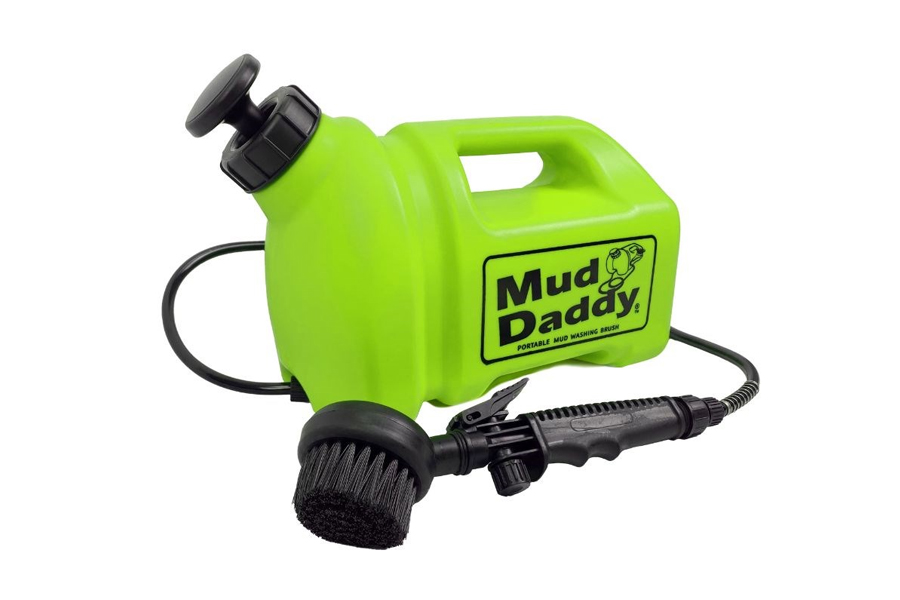
- Manage the temperature. Motorhomes can heat up quickly, especially when parked in the sun. Open skylights and windows when you’re stationary and use blinds, fans or flyscreens to keep the airflow going. If it’s warm enough for shorts, it’s warm enough to check your dog isn’t overheating.
Outside the Caravan
- Set up an awning. Awnings are brilliant for dogs. They give them a safe outdoor space to stretch out, relax, or just watch the world go by, and they effectively double your dog’s freely available exploration space.
- Use a dog tether. If you’re spending time outside and want your dog to join you, a ground peg with a long lead or retractable line is ideal. You can relax without worrying they’ll wander off.
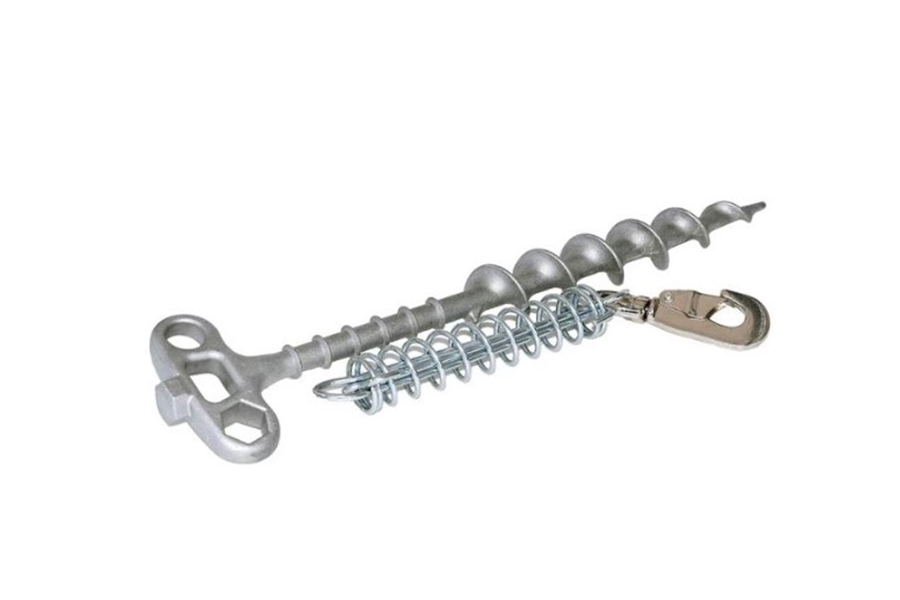
- Give them an outdoor bed. A waterproof mat, raised dog bed or picnic blanket works well. Place it in the shade if it’s hot, and near you so they still feel part of the group.
Where Do Dogs Sleep in a motorhome?
In a motorhome, your dog can sleep just about anywhere that’s safe and suits your setup. Some curl up in their crate on the floor, some sprawl across the passenger seat, and some will happily climb into bed with you.
If you’ve got a smaller motorhome, it helps to pick a consistent sleeping spot so your dog knows where to settle. That might be on the bench seat or tucked into a quiet corner with their favourite blanket.
For dogs who prefer fresh air, some owners let their dogs sleep in the awning. Just make sure it’s fully enclosed and the site rules allow it.
At the end of the day, it’s all about what works for your dog and gives you all a good night’s sleep.
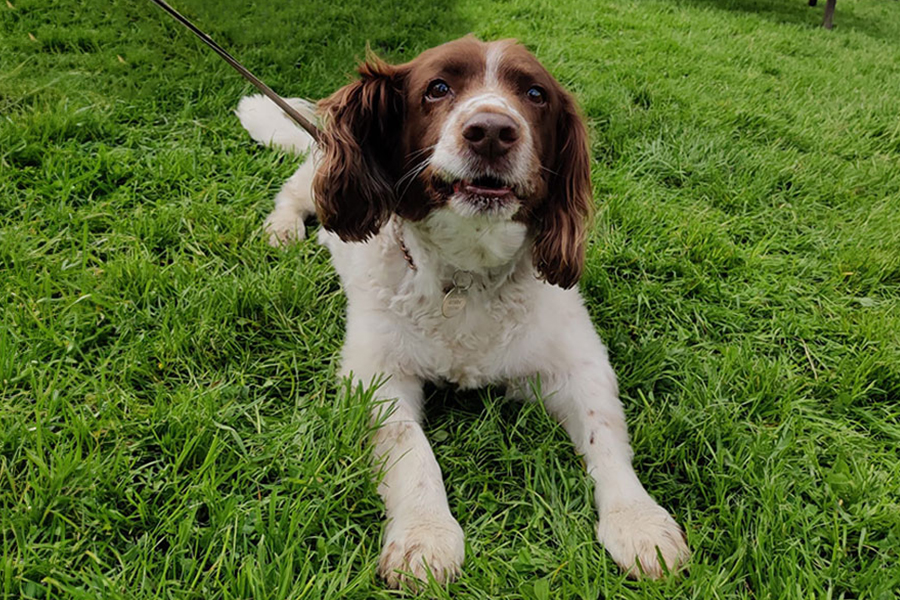
What to pack for taking your dog in a caravan?
Essentials
- Dog poo bags
- Doggy shampoo
- Extra food and water
- Familiar food and treats
- Dog towel
- Spare leash and collar
- Pet peg
- Documentation showing vaccination history
- Dog passport
Health and Safety
- Doggie medicine
- Dog brush
- Collar with your contact details
Comfort and Entertainment
- Dog toys
- Dog towel
- Dog brush
Travel
- Dog car harness / Dog seat belts
- Dog crate / Travel crate
What campsite etiquette for dogs should you be aware of?
Motorhomes make brilliant bases for dog-friendly holidays, but a little campsite etiquette helps keep things smooth for everyone.
- Keep your dog on a lead: Unless you’re in a designated off-lead area, it’s safest to keep them close. Even the calmest dogs can get overexcited in new places full of new sensory experiences.
- Never leave your dog unattended: Even if you’re just popping out for a quick moment, leaving your dog alone in the caravan or awning isn’t a good idea, especially in warm weather. You can be sure of your dog’s wellbeing by keeping them with you.
- Always clean up after them: Simple but important. Bring plenty of poo bags (biodegradable if you can) and use the bins provided. It’s one of the easiest ways to stay in everyone’s good books.
- Be mindful of barking: Dogs will bark, but if yours is getting anxious or noisy outside, especially during quiet hours, it’s worth bringing them inside for a bit of calm.
- Ask before saying hello: Not all dogs, or other owners, are ready to meet others. It’s always polite to check before letting your dog approach someone else’s pitch.
- Check each site’s rules: Every campsite is a bit different. Some won’t allow dogs in shared spaces like playgrounds or clubhouses, and others may have specific leash or noise policies. A quick check when you arrive keeps everything simple.
- Pick your pitch wisely: If your dog’s easily stimulated, consider booking a quieter pitch. One near a walking trail or at the end of a row. A bit more space and fewer distractions can make all the difference.

How to get your dog familiar with motorhoming?
Start with a small trip
Begin with a short, local outing. Let your dog explore the motorhome while it’s parked, giving them time to sniff around and get comfy. Bring familiar items like their bed, toys or blanket so it already feels a bit like home.
Once they’re happy in the space, try a short drive. Then slowly build up to longer journeys so the driving and noise of the motorhome don’t come as a shock.
Get your dog used to the crate being a safe space
If you’re planning to use a crate for travel or sleeping, help your dog see it as a safe place. Set it up at home with familiar smells and treats, and reward them for going in and relaxing. A few test drives with the crate can help settle your dog’s nerves.
Stick to your dog’s usual routine
Dogs thrive on consistency. So, try to keep mealtimes, walks and bedtime roughly the same as at home. This will reduce the amount of variables you’re introducing and gives them something predictable in a new environment. If they usually sleep in a crate or on a travel bed, keep it the same on the road.
Prepare your entire family
If you’ve got younger kids, it’s worth helping them get used to holidaying with the dog too. Encourage calm, respectful play inside the van and give kids small jobs like topping up the water bowl or helping with the lead. It teaches responsibility and keeps things running smoothly.
Gradually build their confidence
Introduce your dog to different environments ahead of time: service stations, parks, or quiet campsites. If they’re nervous, try playing sounds like traffic or campsite noise at home to desensitise them gradually to the kinds of things you’ll see on holiday.
What if your dog has an emergency when motorhoming?
- Pack a dog first-aid kit: Just in case. Include tick tweezers, bandages and anything your dog regularly needs.
- Save local vet numbers: Do this before you travel so you’re not scrambling in a panic.
- Download a pet care app: Pet First Aid UK and Dog Tracker Plus are both handy to have.
- Look at your caravan insurance: Some policies cover pets, but not all. Worth double-checking before you go.
What to do first when you return home?
Return & Recovery
Once you’re home, give your dog a good clean and dry-off, especially if they’ve been swimming, rolling, or just generally embracing the great outdoors.
Wash any blankets or bedding, wipe down their bowls, and get rid of any muddy paw prints before they set in.
Some dogs can feel a bit out of sorts after a busy trip, so ease them back into their usual routine gently.
And while it’s fresh in your mind, pack all their gear into a grab-and-go box: leads, bowls, towels, treats, so you’re ready to hit the road again with minimal fuss next time.
Planning a long journey or a holiday with your pets?
Motorhome holidays are perfectly designed for dog lovers, but a long journey takes a bit of planning. Whether it’s your first or fiftieth holiday with your pets, don’t forget to check the small stuff.
Comfort, safety and routine go a long way toward keeping those tails wagging.
Looking for more dog-friendly travel tips?
Check out these helpful reads from Bailey:
Latest news & events
See all news & eventsCaravan Tech Annual Open Weekend
Caravan Tech, Merriments, Hawkhurst Road, Hurst Green, East Sussex

